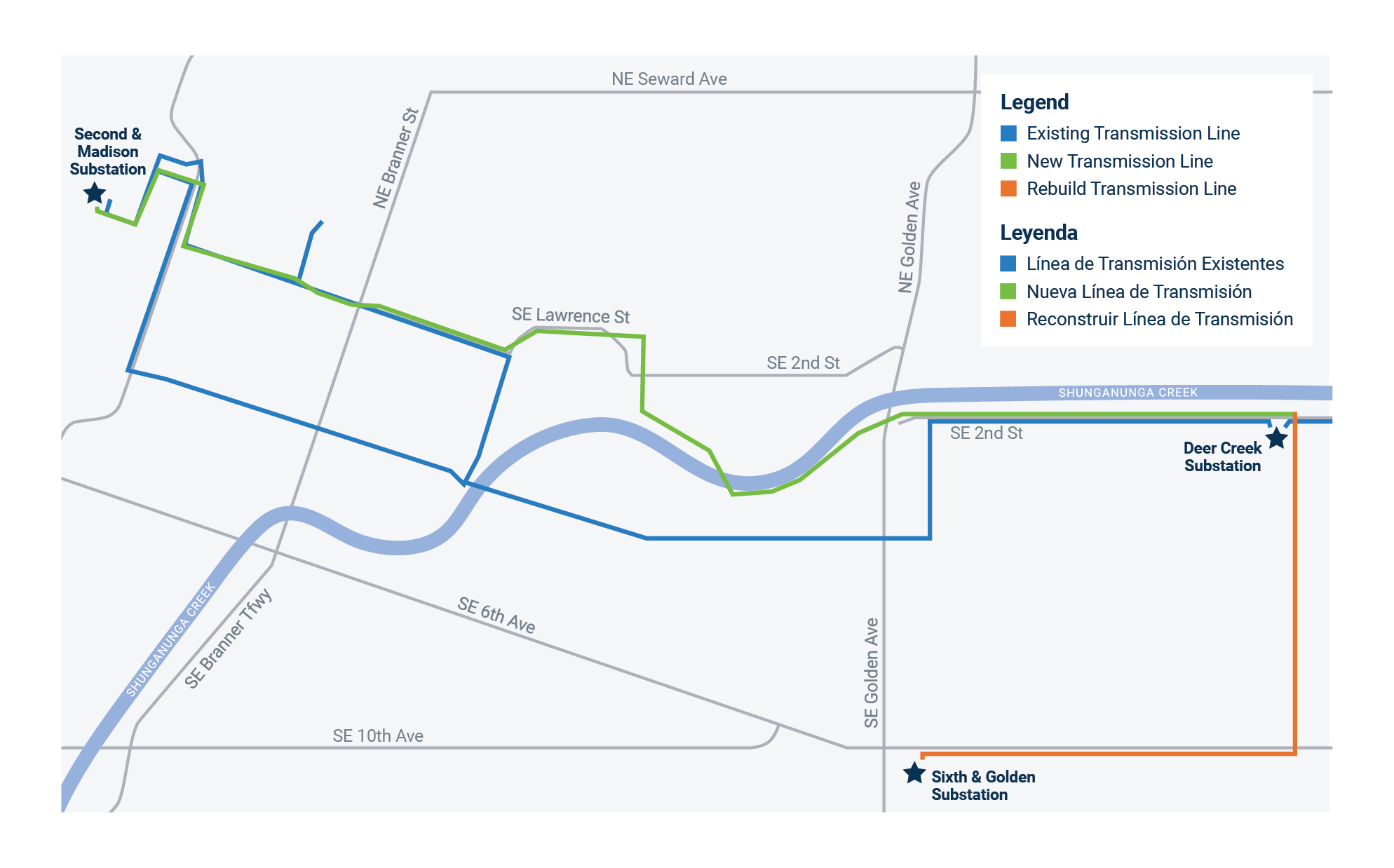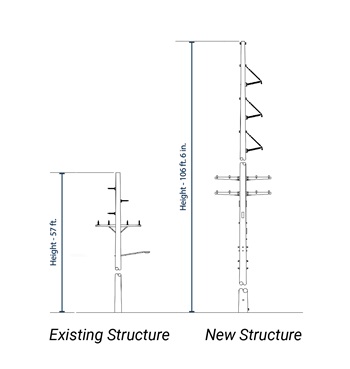Topeka Transmission Line Upgrade
Evergy is preparing to upgrade an aging power system built in the 1940s that is nearing the end of its service life (en español).
What to expect
- We will build a new 115 kV transmission line connecting the Second and Madison substation, located at Second and Madison streets, to the Deer Creek substation, located near Second Street and Kellam Avenue.
- We will also rebuild the existing 34.5 kV transmission line with a new 115 kV transmission line connecting the Deer Creek substation to the Sixth and Golden substation, located at Sixth and Golden avenues.
- Once the new transmission line is operational, the 69 kV transmission line connecting the Second and Madison substation to the retired Tecumseh Energy Center will be removed. The distribution line will remain, but sections will be rebuilt to continue serving customers in the area.
Project Map

Benefits
The improvements will enhance electric reliability for the community, as well as strengthen the regional power grid. This project is part of Evergy’s long-range plan to upgrade the transmission grid in eastern Kansas and strengthen electric reliability in the Topeka area.
Timeline

Regulatory and Government Policy
Kansas Corporation Commission (KCC) regulates and has the responsibility of ensuring electric utilities provide safe, adequate and reliable services at reasonable rates. The mission of the KCC is to protect the public interest through impartial and efficient resolution of all jurisdictional issues.
Southwest Power Pool (SPP) is a Regional Transmission Organization (RTO), mandated by the Federal Energy Regulatory Commission (FERC) to ensure reliable supplies of power, adequate transmission infrastructure and competitive wholesale prices of electricity. SPP operates subject to a tariff filed with and governed by FERC. This tariff contains over 2,100 pages of rates, terms and conditions for providing transmission service to SPP’s customers to move wholesale electric power within and across SPP’s 17-state footprint.
Federal Energy Regulatory Commission (FERC) regulates the transmission and wholesale sales of electricity in interstate commerce and ensures the reliability of high-voltage interstate transmission systems.
Evergy, Inc. (Evergy) (NYSE: EVRG) serves approximately 1.6 million customers in Kansas and Missouri. We generate nearly half the power we provide to homes and businesses with emission-free sources. We support our local communities where we live and work, and strive to meet the needs of customers through energy savings and innovative solutions.
Here's what you can expect for the pole design of this project: 
- The poles will be round steel monopoles. Steel poles are utilized for reliability and resiliency with the harsh weather conditions our communities can face. Existing structures are round wood monopoles and square steel lattice structures.
- Spacing between each pole will be between 150 to 350 feet, with some up to 650 feet apart. Existing structures are 175 to 300 feet apart.
- The base of each pole for most of the line will be two to four feet in diameter. The base of certain turning structures could be seven to nine feet in diameter. Existing lattice structures have a three-by-three feet square base and existing turning structures have a nine-by-nine feet square base.


Evergy is preparing to upgrade an aging power system built in the 1940s that is nearing the end of its service life.
- We will build a new 115 kV transmission line connecting the Second and Madison substation, located at Second and Madison streets, to the Deer Creek substation, located near Second Street and Kellam Avenue.
- We will also rebuild the existing 34.5 kV transmission line with a new 115 kV transmission line connecting the Deer Creek substation to the Sixth and Golden substation, located at Sixth and Golden avenues.
- Once the new transmission line is operational, the 69 kV transmission line connecting the Second and Madison substation to the retired Tecumseh Energy Center will be removed. The distribution line will remain, but sections will be rebuilt to continue serving customers in the area.
Why is this line needed?
The improvements will enhance electric reliability for the community, as well as strengthen the regional power grid. This project is part of Evergy’s long-range plan to upgrade the transmission grid in eastern Kansas and strengthen electric reliability in the Topeka area.
Who will benefit from the project?
This project will benefit residents and businesses in Topeka, eastern Kansas and beyond by strengthening the regional power grid and improving reliability. It also will provide tax revenue, construction jobs, local expenditures and will expand capabilities for future investment in area industry.
Who is responsible for this project?
Evergy will construct and own the new transmission line. The Southwest Power Pool (SPP) operates the transmission system in the region for this transmission line. SPP will direct Evergy to operate the new transmission line.
When will the line be built?
The project is scheduled to be complete and in-service by December 2022. We are forecasting construction work to begin in May 2022.
What will the line look like?
- The poles will be round steel monopoles. Steel poles are utilized for reliability and resiliency with the harsh weather conditions our communities can face. Existing structures are round wood monopoles and square steel lattice structures.
- The poles will be 60 to 95 feet tall where there is no distribution line and 90 to 110 feet tall where there is distribution line. Existing structures are 50 to 80 feet tall.
- Spacing between each pole will be between 150 to 350 feet, with some up to 650 feet apart. Existing structures are 175 to 300 feet apart.
- The base of each pole for most of the line will be two to four feet in diameter. The base of certain turning structures could be seven to nine feet in diameter. Existing lattice structures have a three-by-three feet square base and existing turning structures have a nine-by-nine feet square base.
With the completion date in the distant future, why is this line now being discussed?
Transmission projects require many years to permit, design, procure materials and construct. Almost all the major components are custom built and require long lead times.
How will right-of-way be acquired for this project?
We are committed to transparent and timely communications with landowners. We will contact landowners who have property on the transmission line route to discuss purchasing the easements necessary to build the line. This will allow property owners to continue most uses of their property. One-time payments are provided, typically negotiated up-front, based on determination of the market property values in the local area or based on the value of the easement as it affects the property. We will work respectfully with landowners throughout the process to minimize impacts to their properties. It is our goal to reach negotiated agreements with all landowners.
What if Evergy can't come to an agreement with landowners?
Fortunately, that is a rare occurrence. Evergy will make every effort to reach negotiated agreements. Evergy may exercise the right of eminent domain to obtain an easement after exhausting attempts through negotiations with a landowner.
Who will build the lines and manage the construction?
Evergy will design and construct the transmission line using both Evergy resources and subcontractors depending on the task. Evergy will provide project management services and coordination during construction of the project.
How much will the project cost?
Since the project isn’t complete, final costs haven’t been determined, but the initial estimated investment is approximately $23 million. Because the project will entirely benefit Evergy customers, costs will be reflected in customer rates through the transmission delivery charge.
What environmental impacts will be considered with the siting of the project?
Evergy believes the environment is an important factor when planning and designing transmission line projects. We work closely with appropriate organizations, including the Kansas Department of Wildlife, Parks and Tourism, Kansas Historical Society, the U.S. Fish and Wildlife Service and the Nature Conservancy from the beginning of projects to make sure any direct environmental impact is appropriately identified and addressed. We believe this kind of collaboration leads to developing a transmission line route that aligns with federal and state energy and environmental policy objectives. We adhere to all state and federal regulations to protect native plants, threatened or endangered species, wetlands and water and air quality.
Regulatory and Government Policy
Which regulatory bodies will have to approve the project?
The Kansas Corporation Commission (KCC) is the regulatory body with oversight regarding the siting of such transmission line projects in the state of Kansas. We will be required to obtain an Electric Service Line permit from the KCC.
Participants:
Kansas Corporation Commission (KCC)
The KCC regulates and has the responsibility of ensuring electric utilities provide safe, adequate and reliable services at reasonable rates. The mission of the KCC is to protect the public interest through impartial and efficient resolution of all jurisdictional issues.
Southwest Power Pool (SPP)
The SPP is a Regional Transmission Organization (RTO), mandated by the Federal Energy Regulatory Commission (FERC) to ensure reliable supplies of power, adequate transmission infrastructure and competitive wholesale prices of electricity. SPP operates subject to a tariff filed with and governed by FERC. This tariff contains over 2,100 pages of rates, terms and conditions for providing transmission service to SPP’s customers to move wholesale electric power within and across SPP’s 17-state footprint.
Federal Energy Regulatory Commission (FERC)
FERC regulates the transmission and wholesale sales of electricity in interstate commerce and ensures the reliability of high-voltage interstate transmission systems.
Evergy, Inc. (Evergy)
Evergy, Inc. (NYSE: EVRG) serves approximately 1.6 million customers in Kansas and Missouri. We generate nearly half the power we provide to homes and businesses with emission-free sources. We support our local communities where we live and work and strive to meet the needs of customers through energy savings and innovative solutions.